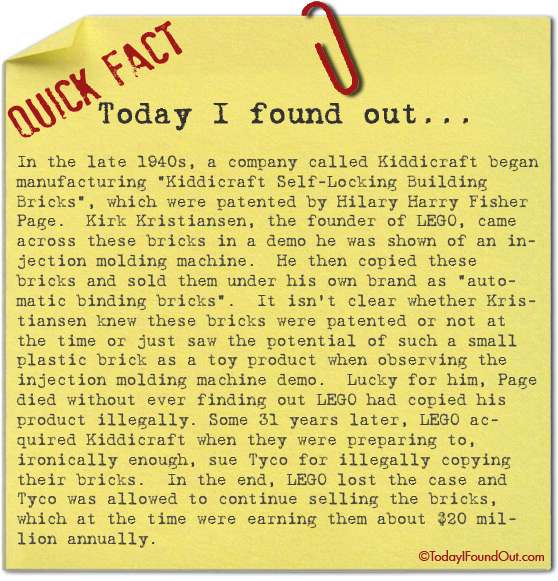LEGO Stole Their Bricks From Kiddicraft’s Patented Self Locking Building Bricks
##EMBED##
Click Here for Sources and to Learn More Interesting Lego Facts
In the late 1940s, a company called Kiddicraft began manufacturing “Kiddicraft Self-Locking Building Bricks”, which were patented by Hilary Harry Fisher Page. Kirk Kristiansen, the founder of LEGO, came across these bricks in a demo he was shown of an injection molding machine. He then copied these bricks and sold them under his own brand as “automatic binding bricks”. It isn’t clear whether Kristiansen knew these bricks were patented or not at the time or just saw the potential of such a small plastic brick as a toy product when observing the injection molding machine demo. Lucky for him, Page died without ever finding out LEGO had copied his product illegally. Some 31 years later, LEGO acquired Kiddicraft when they were preparing to, ironically enough, sue Tyco for illegally copying their bricks. In the end, LEGO lost the case and Tyco was allowed to continue selling the bricks, which at the time were earning them about $20 million annually.
| Share the Knowledge! |
|






LEGO didn’t stole no patented idea, at least ‘technically’, since in Scandinavian countries Self Locking Building Bricks were never patented. LEGO entered in a joint venture together to Swedish GEAS and Prima (maybe Norwegian) to make available these bricks in then ultra protectionist Scandinavian markets. Kiddicraft SLBBs were just one of the bunch of products created by Hillary Fisher Page, and one of the less successful ones, with poor sales (British kids preferred the more versatile Minibrix ones). Since SLBB were quasi an experimental toy with uncertain future is surely incorrect to think OLe Kirk Christiansen as a profiteer moved by greed, like someone interested vaguely painted him. From 1953, while SLBBs sets were the usual two-bricks-and-three-windows-and-a-doors-panes ones, TLG were already producing a bettered product with more pieces, now on his own, with just superficial similarities with previous Automatic Binding Bricks one. SLBBs production stopped in 1955, leaving on shelves just the big interlocking cubes for babies, while a quasi different product by that time was becoming a XX century hit.
@Marco: Sources?
Ah, I forgot:
* http://www.legos.tabacaria.com.pt/Pt2/txtBk/50a.htm
What Marco says is pretty much correct. Ole Kirk Christiansen did buy the plastic molding machine from a British company that made them for Kiddicraft. However, Kiddicraft was only patented in Britain, Switzerland and France. So none of Scandinavia had a patent.
Although it is true that the Automatic Binding Bricks were based on the designs of Kiddicraft, this was a common practice in Europe at the time of copying other peoples toy systems. Since no patents were forthcoming in either Denmark, Norway or Sweden, Ole Kirk Christiansen was free to produce similar brick designs. And they were not alone in doing so… other companies such as ABC Copex, PeBe and over a dozen other companies also designed their products in a similar fashion to Kiddicraft. Check out this Dutch website…
http://www.leggodt.nl/items/lego/en/isthislego/
One thing that appears certain was that Ole Kirk Christiansen WAS worried about “potential” patent infringement in the future, which is why his early bricks did not mention LEGO on the bricks or on the box. And yes the Automatic Bricks were subcontracted to GEAS (Sweden early 1950s) and Svein Stromberg (Norway, maker of LEGO and PRIMA for the Norwegian and Swedish market in the mid-to-late 1950s).
Cough’ Theft’ cough